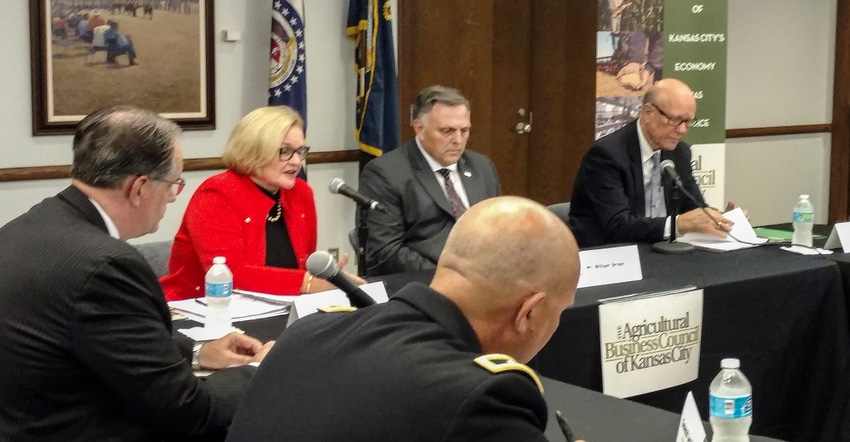
Editor’s Note: This is one of a series of stories about the threat of agroterrorism and maintaining food security.
Working together in the interest of agricultural and food security is nothing new for Sens. Claire McCaskill, D-Mo., and Pat Roberts, R-Kan.
McCaskill was a big supporter of Roberts’ efforts to enhance research in animal disease that resulted in the construction of the Biosecurity Institute, which was completed in 2007 and began research projects in 2009. She also supported the decision to construct the new National Bio and Agro-Defense Facility on the campus of Kansas State University in Manhattan. It is slated to be completed in 2021 and operational late in 2022.
It will replace the aging Plum Island Animal Disease Center in New York. That facility is not equipped for large-animal containment projects and is nearing the end of its lifespan. The new facility in Manhattan will also have the advantage of being located in the Kansas City Animal Health Corridor, the largest concentration of animal health companies in the world.
“I never thought I’d work so hard for something in Kansas,” McCaskill quipped. “This is important for Missouri, Kansas and the nation. Food security is national security, and we can’t risk the disaster of not being prepared.”
As work on the new facility has progressed, research at the existing BSI on the K-State campus has advanced steadily, with several projects designed to be ready to seamlessly move into the new facility when it comes available.
As research has moved forward, so too has the pressure to keep this work in the foreground. West Nile virus, Rift Valley fever and Zika virus are all vector-borne diseases that have emerged in recent years and threaten the health of Americans.
In early August, Roberts and McGaskill gathered input from a roundtable of national, state and local leaders in Kansas City, Mo., hearing about the progress that has been made in agroterrorism and food security and gaining insight on what still needs to be done.
They determined that joint hearings on the topics of protection from agroterrorism and food security need to be held in the coming weeks to focus new attention on the need to protect agriculture and the food chain from attack.
Roberts said he first realized the urgency of preparedness when he visited the former Soviet Union shortly after the fall of the Iron Curtain and saw the “secret cities” of the region — warehouses full of pathogens developed for the express purpose of attacking a nation’s food supply to disrupt its ability to wage war.
Roberts, who is known for his sense of humor and wry wit, said he turned to his wife after the tour and said, “You know they’re going to invite us to lunch next. I know you don’t like vodka, but maybe we should gargle with a little bit of it.”
Roberts visited with then-K-State dean Jon Wefald about the need for a preparedness effort and in March of 1999, K-State proposed the Homeland Defense Food Safety and Security and Emergency Preparedness Program.
The terrorist attacks of 9/11 added new emphasis to the need for preparedness, and in 2003 the first concept for the Biosecurity Research Institute at Kansas State University was proposed just in time for the discovery of the first U.S. case of bovine spongiform encephalopathy — the “cow that stole Christmas” — in December of 2003. Construction started in 2007, and Pat Roberts Hall, housing a Bio-Security Level 3 laboratory in addition to other labs, classrooms and administrative space, was dedicated. Research programs for plant and animal pathogens began in 2009 after extensive testing of the lab and its security features.
In recent years, however, the spotlight on food security has faded somewhat and funding for research has eroded. The senators agreed that the time is right to push for a new focus on making sure that all the moving parts of the system that works to protect the food supply have the resources they need and that efforts are well coordinated.
Escalating tensions on several world stages from Russia to North Korea, to ISIS, al-Qaida and other terrorist groups are constant reminders of those warehouses of pathogens that are still so vivid in Roberts’ mind.
Next: The success of building a “vaccine bank” and need to refine the deployment infrastructure.
About the Author(s)
You May Also Like




